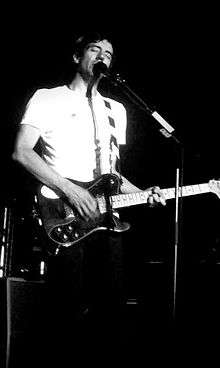University of Dundee
 | |||||||||||||||
| Latin: Universitas Dundensis | |||||||||||||||
| Motto | Latin: Magnificat anima mea dominum[1] | ||||||||||||||
|---|---|---|---|---|---|---|---|---|---|---|---|---|---|---|---|
Motto in English | "My soul doth magnify the Lord" | ||||||||||||||
| Type | Public university | ||||||||||||||
| Established |
1967 - gained independent university status by Royal Charter 1897 - Constituent college of the University of St Andrews 1881 - University College | ||||||||||||||
| Endowment | £25 million (2015)[2] | ||||||||||||||
| Budget | £254 million (2015)[2] | ||||||||||||||
| Chancellor | The Lord Patel of Dunkeld | ||||||||||||||
| Rector | Mark Beaumont | ||||||||||||||
| Principal | Sir Peter Downes | ||||||||||||||
Academic staff | 2,420[3] | ||||||||||||||
Administrative staff | 1,745[3] | ||||||||||||||
| Students | 15,180 (2014/15)[4] | ||||||||||||||
| Undergraduates | 10,200 (2014/15)[4] | ||||||||||||||
| Postgraduates | 4,980 (2014/15)[4] | ||||||||||||||
| Location | Dundee, Scotland | ||||||||||||||
| Colours |
| ||||||||||||||
| Affiliations |
ACU DSC IMU SICSA | ||||||||||||||
| Website |
www | ||||||||||||||
|
| |||||||||||||||
The University of Dundee (abbreviated as Dund. for post-nominals) is a public research university based in the city and Royal burgh of Dundee on the east coast of the central Lowlands of Scotland. It is consistently ranked within the Top 250 universities in the world and inside the Top 100 for certain disciplines.[5] It is also in the list of 39 elite UK universities, which includes the 22 non-Oxbridge universities of the Russell Group.[6][7]
Founded in 1881 the institution was, for most of its early existence, a constituent college of the University of St Andrews alongside United College and St Mary's College located in the town of St Andrews itself. Following significant expansion, the University of Dundee became an independent body in 1967 whilst retaining much of its ancient heritage and governance structure. Since its independence, the university has grown to become an internationally recognised centre for research.
The main campus of the university is located in Dundee's West End and consists of a mixture of Victorian, Edwardian and postmodern architecture. Many of the university's teaching and research facilities are concentrated within this area, from the Discovery Research Centre and the Duncan of Jordanstone College of Art and Design on the western edge to Dundee Law School and the Dundee Dental Hospital and School on the eastern edge, with the student union, campus green and main library among other features situated in-between. The university also has additional facilities at Ninewells Hospital – containing its School of Medicine, Perth Royal Infirmary – which houses a clinical research centre, and in Kirkcaldy, Fife – containing part of its school of Nursing and Midwifery. Dundee has developed a significant reputation for students entering the traditional professions, most notably law, medicine and dentistry as well as emerging areas such as life sciences[8] and art.
History
Foundation
The University of Dundee has its roots in the earlier University college based in Dundee and the University of St Andrews. During the 19th century, the growing population of Dundee significantly increased demand for the establishment of an institution of higher education in the city and several organisations were established to promote this end, including a University Club in the city. At the same time, the University of St Andrews was, as were the other universities in Scotland at the time, suffering from significant financial problems. Moreover, St Andrews' position, isolation and small size (160 students as opposed to the University of Aberdeen, with a roll of around 700) contributed to a significant decline. In a submission to a Royal Commission established to investigate the problems at St Andrews, Heddle, a lecturer in chemistry, observed that
| “ | If we could be transferred to Dundee, I believe we could live and perhaps flourish; but if not, I think we will gradually cease to live. | ” |
There was a significant movement with the intention of moving the entire university to Dundee (which the Royal Commission observed was now a "large and increasing town") or the establishment of a college along very similar lines to the present United College. Finally, agreement was reached that what was needed was expansion of the sciences and professions, rather than the arts at St Andrews.
In the early 1870s, construction began on the North British Railway's Tay Bridge which cut journey times between Dundee and St Andrews enormously and allowed for a third option between the status quo and complete movement: the creation of what was foreseen as a "University of Dundee and St Andrews", situated between two campuses, each with their own particular specialities.
A donation of £120,000 for the creation of an institution of higher education in Dundee was made by Miss Mary Ann Baxter of Balgavies, a notable lady of the city and heir to the fortune of William Baxter of Balgavies. In this endeavour, she was assisted by her relative, Dr John Boyd Baxter, an alumnus of St Andrews and Procurator Fiscal of Forfarshire who also contributed nearly £20,000. In order to craft the institution and its principles, it was to be established first as an independent university college, with a view from its very inception towards incorporation into the University of St Andrews.
In 1881 the ideals of the proposed new college were laid down, suggesting the establishment of an institute for "promoting the education of persons of both sexes and the study of Science, Literature and the Fine Arts".[9][10] No religious oaths were to be required of members. Later that year, "University College, Dundee" was established as an academic institution and the first principal, William Peterson, was elected in late 1882. When opened in 1883, it comprised five faculties: Maths and Natural Philosophy, Chemistry, Engineering and Drawing, English Language and Literature and Modern History, and Philosophy. The University College had no power to award degrees and for some years students were prepared for external examinations of the University of London.[11]
The policy of no discrimination between the sexes, which was insisted upon by Mary Ann Baxter, meant that the new college recruited several able female students. Their number included the social reformer Mary Lily Walker and, later, Margaret Fairlie who in 1940 became Scotland's first female professor.[12][13]
Incorporation into the University of St Andrews

Following several aborted attempts at various forms of incorporation and association, in 1890 the college began to establish closer links with the University of St Andrews, a process which was completed in 1897 when University College became part of the University of St Andrews. This move was of notable benefit to both, enabling the University of St Andrews (which was in a very small burgh (roughly equivalent to a conurbation), and remains so) to support a medical school. Medical students could choose to undertake preclinical studies either in Dundee or St Andrews (at the Bute Medical School) after which all students would undertake their clinical studies at Dundee. Eventually, law, dentistry and other professional subjects were taught at University College. By 1904 University College had a roll of 208, making up 40 per cent of the roll of the University generally. By session 1909-10 234 students were studying at University College, 101 of whom were female. Among the notable students at this time were Robert Watson-Watt, the radar pioneer; William Alexander Young the epidemiologist who later died in Accra while studying yellow fever; and David Rutherford Dow who would go on to be a senior member of staff at the college.[14]
University College's development in the early twentieth century has been described as "slow and fitful" and the interwar period saw virtually no new building projects, leaving large parts of the college housed in buildings which were not fit for purpose.[15] Attempts were made to raise income. In 1923 Rudyard Kipling, then the Rector of the University of St Andrews, visited University College and asked the merchant princes and leading citizens of Dundee to give the College their money and support. Kipling implored those who had lost their sons in the Great War to consider giving a donation so that their names would live on.[16] Staff of a high calibre continued to be employed by the University including Alexander Peacock and Margaret Fairlie, who in 1940 was appointed as Professor of Obstetrics and Gynaecology and thus became the first woman to hold a professorial chair at a university in Scotland.[15][17]
In 1947, the Principal of University College, Douglas Wimberley released the "Wimberley Memo" (resulting in the Cooper and Tedder reports of 1952), advocating independence for the College. In 1954, after a Royal Commission, University College was renamed "Queen's College" and the Dundee-based elements of the University gained a greater degree of independence and flexibility. It was also at this time that Queen's College absorbed the former Dundee School of Economics.
Creation of the University of Dundee
| “ | to advance and diffuse knowledge, wisdom and understanding by teaching and research | ” |
The publication of the Robbins Report on Higher Education in 1963, which considered the question of university education expansion throughout the country, provided impetus to the movement to attain independent university status for Dundee. At this time, a number of new institutions were being elevated to this status, such as the University of Stirling, and second universities were created in Edinburgh and Glasgow (Heriot-Watt University and the University of Strathclyde) despite their having fewer than 2,000 students. Queen's College's size and location, alongside a willingness to expand, led to an eventual decision to separate from the wider University of which it remained an integral part. In 1966, St Andrews University Court and the Council of Queen's College submitted a joint petition to the Privy Council seeking the grant of a Royal Charter to establish the University of Dundee. This petition was approved and the Charter[18] was granted which saw Queen's College become the University of Dundee, on 1 August 1967. The university continued a number of the traditions of its originator college and university and continues to be organised under the ancient university governance structure.
Modern developments

The University of Dundee has grown considerably since securing independent university status. The teaching of medicine, dentistry, law, engineering, nursing, social work and accountancy flourished, and a new Faculty of Letters (later renamed the Faculty of Arts) was developed. Dundee is the only university in the UK to offer an LLB in both English law and Scottish Law and to allow law students to dual qualify.
In 1974 the University began to validate some degrees from Dundee's Duncan of Jordanstone College of Art and Design, and by 1988 all degrees from that institution were being validated in this fashion. In 1994 the two institutions merged, with the college becoming a constituent faculty of the university. In 1996, the Tayside College of Nursing and the Fife College of Health studies became part of the university, as a school of Nursing and Midwifery. For several years, Dundee College of Education prepared students for degree examinations at the University of Dundee, and in December 2001 the university merged with the Dundee campus of Northern College to create a Faculty of Education and Social Work.
In October 2005, the university became home to the first UNESCO centre in the United Kingdom. The IHP-HELP Centre for Water Law, Policy and Science is involved in research regarding the management of the world's water resources on behalf of the United Nations.[19] A school of accounting and finance was introduced in 2007.[20]
The 2000s brought extensive renovation to the university's central campus, culminating in a number of new and upgraded buildings being introduced around 2007 to celebrate the 40th anniversary of the university's independence. Large extensions have been placed on the Main Library and sports centre, and a number of new halls of residence (Heathfield, Belmont, West Park and Seabraes) have been gradually phased into operation. The Dalhousie building was erected during this period as dedicated teaching accommodation for the University, in part replacing space previously at the Gardyne Road campus of Northern College, which has now been taken up by Dundee College. Significant improvement works have taken place in old buildings such as the Old Technical Institute, Medical Sciences Institute and Old Medical School buildings.
Campus
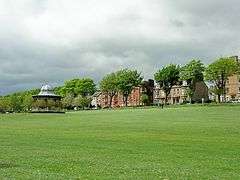
The University is largely based within the West End of the City of Dundee, which has been subject to a large degree of studentification and an expansion of both the university and the city centre to meet.[21]
City Campus
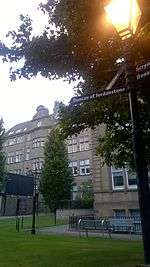
The main campus has expanded greatly since the University gained independence, from just four converted buildings when the University College was founded in 1881 the University has grown to consist of over fifty at present. However, many buildings survive from Dundee's period as a University College and as a constituent college of St Andrews University. One of the earliest purpose-built facilities on campus was the Carnelley Building, a £10,000 donation from Miss Mary Ann Baxter provided for a state-of-the-art chemistry laboratory situated in the building which was named for the University's first Professor of Chemistry, Thomas Carnelley.[22]
The iconic buildings at the heart of the university which form the Geddes Quadrangle, including the Carnegie Building, the Harris Building and the Peters Building were constructed in 1909 as the new college of the University of St Andrews started to thrive.[23] The Geddes Quadrangle was named for Professor Patrick Geddes, a pioneering thinker in the fields of sociology and urban planning and former Professor of Botany at Dundee, as a botanist Geddes had originally proposed a garden in the center of the quadrangle to be used for teaching purposes.[24] The designer of this grandiose architecture was renowned Victorian architect Robert Rowand Anderson, the architect of many of Scotland's most prestigious buildings such as the Scottish National Portrait Gallery and Mount Stuart House.[25]
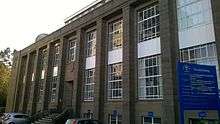
Amid the expansion of education in post-war Britain the University College, Dundee commissioned the construction of several new buildings to cope with the increasing numbers of students and academics arriving. The first of these was the Ewing Building which had started planning in 1950 and was officially opened in 1954, named after Professor Sir James Alfred Ewing, the University's first Professor of Engineering, the building currently houses postgraduate research facilities for the engineering and physics disciplines as well as the NERC Satellite Receiving Station.[26][27] The Fulton Building gave the civil and mechanical engineering department a dedicated building having previously been consigned to work in neglected buildings such as old jute sheds, it was opened in 1964 and took its name from Angus Robertson Fulton, former principal of University College, Dundee (1939–1946).[28]
The 1960's saw the further development of the Queens College campus with some of the earliest multi-story towers in Scotland being built for both teaching and student accommodation. The Tower Building, opened in 1961, exemplified early Scottish modernist architecture; it stands 140ft tall with ten storeys home to both academic and administrative departments of the University.[29][30] At a time where student living lacked a certain element of grace and comfortability, Belmont Halls of Residence took inspiration from Danish design and aimed to provide modern, spacious quarters for students while keeping costs cheap; it was completed in 1963 on the site of Belmont Works, a former jute mill.[31]
Governance and organisation
Governance
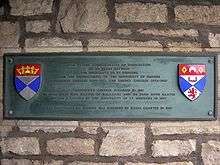
The University of Dundee is organised under the provisions of its Royal Charter, which granted the university its independence in 1967.[18] The University of Dundee, uniquely outside of the four ancient universities of Scotland has a governance framework which shares a number of similarities with the ancient governance structure which was developed in the 19th and 20th centuries through the various Universities (Scotland) Acts.
Chancellor
The Chancellor is the head of the university and President of the Graduates' Council, with a role of presiding over Academic Ceremonies such as graduations.[32] The four Chancellors of the university to have held office since its independence are:
- Her Majesty Queen Elizabeth the Queen Mother (1967–1977)
- The Earl of Dalhousie (1977–1992)
- Sir James W. Black OM (1992–2006)
- Lord Patel of Dunkeld, KT (2006 – present)[33]
Rector
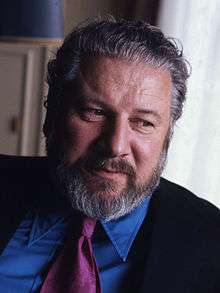
The Rector of the University is an official elected by the matriculated students of the university for a three-year term.[34] In common with other university rectors in Scotland, the position is largely ceremonial, although it does involve the representation of students on the University Court. The Rector at Dundee, unlike that of the ancient universities, does not chair the University Court, that duty instead falling to a lay member.[35] The Rector may appoint an Assessor who can carry out the Rector's functions on his behalf when he is absent. The university gained national attention in 2001 when it seemed that actor David Hasselhoff may stand as rector.[36]
As part of the process of installation, the students traditionally take the new Rector on the 'rectorial drag' which involves them being 'dragged' from the City Chambers to the University in the University's own carriage visiting on the way some of the many pubs in the city as part of the informal welcome to the University.[37]
The present holder of the position is record-breaking cyclist Mark Beaumont, who assumed the position on 25 January 2016. He replaced, Brian Cox CBE, a Dundee-born actor, who served for two terms.
Previous Rectors since the university's independence have included Sir Peter Ustinov, Sir Clement Freud, and Stephen Fry, who each served two terms, and Craig Murray, Tony Slattery, Lorraine Kelly and Fred MacAulay, who each served one.[38][39]
Principal and Vice-Chancellor
The Principal and Vice-Chancellor is the chief academic and administrative officer of the university, presiding over the Senatus Academicus.[40] As a result of his title as Vice-Chancellor, the Principal can fulfill the duties of the Chancellor in his absence. Prior to the university's independence, when it was part of the University of St Andrews, a similar function was carried out by the Master of Queen's College. This position replaced the earlier post of Principal of University College, Dundee, which was first filled in 1882.
Following the resignation of Principal and Vice-Chancellor Sir Alan Langlands in March 2009, the university appointed Pete Downes to the post.[41][42] Holders of this position and its predecessors are:
Principals of University College, Dundee
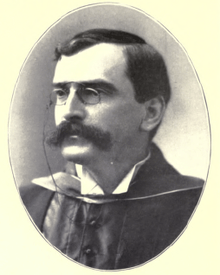
- William Peterson (1882–1895)
- John Yule Mackay (1895–1930)
- Sir James Irvine (1930–1939) - 'Interim' appointment[43][44]
- Angus Robertson Fulton (1939–1946) - 'Interim' appointment[43][44]
- Douglas Wimberley (1946–1954)
Masters of Queen's College, Dundee
- David Rutherford Dow (1954–1958)
- Arthur Alexander Matheson (1958–1966)
- James Drever (1966–1967)
Principals of the University of Dundee
- James Drever (1967–1978)
- Adam Neville (1978–1987)[43]
- Michael Hamlin (1987–1994)[43]
- Ian James Graham-Bryce (1994–2000)
- Sir Alan Langlands (2000–2009)[43][45]
- Professor Sir Pete Downes (2009-)[42]
Structure
As of 1 August 2015, the University of Dundee is organised into nine schools containing multiple disciplines.[46] Each individual school is formally headed by a Dean. The following is a full list of the academic divisions of the university:

|
School of Art and Design School of Humanities
School of Nursing and Health Sciences
|
School of Dentistry
School of Life Sciences
School of Science & Engineering
|
School of Education and Social Work
School of Medicine School of Social Sciences |
Reputation

| ARWU[47] (2016, national) | 22-28 | |
|---|---|---|
| ARWU[48] (2016, world) | 201–300 | |
| QS[49] (2016/17, national) | 34 | |
| QS[50] (2016/17, world) | 244 | |
| THE[51] (2016/17, national) | 28 | |
| THE[52] (2016/17, world) | 180 | |
| CWTS Leiden[53] (2016, world) | 63 | |
| Complete[54] (2017, national) |
35 | |
| The Guardian[55] (2017, national) |
28 | |
| Times/Sunday Times[56] (2017, national) |
28 | |
The University of Dundee graduates more students into the professions (such as law, accountancy, architecture, planning, engineering, medicine and dentistry) than any other Scottish university.[57] The Guardian newspaper named the university's medical school and dental school the best in the United Kingdom in 2008 and 2009. It was also ranked 1st in Scotland in 2015 according to The Guardian newspaper.[58][59][60]
In recent years, its molecular biology, biochemistry and genetics departments have grown to become the most influential in Britain,[61][62] and was awarded a Queen's Anniversary Prize for drug discovery and development. The Centre for Anatomy and Human Identification was also awarded the Queen's Anniversary Prize in 2013. In the 2016-17 Times Higher Education World University Rankings, Dundee was ranked joint 62nd worldwide (and 8th in the UK) for Life Sciences[63] and 80th worldwide (11th in the UK) for Clinical, Pre-Clinical and Health.[64] The university's Duncan of Jordanstone College of Art and Design is ranked among the top three art schools in the UK.[65]
Dundee Law School ranks as one of the top law faculties in the UK; it was ranked 1st in Scotland and 10th in the UK in the 2017 Times Good University Guide.[66] In addition, The Guardian's 2017 league table placed the School 1st in Scotland and 8th in the UK.[67] The Law School also retains high levels of student satisfaction, as evidenced by the National Student Survey 2016 in which Dundee was rated in the UK top 10, taking into account factors such as feedback, staff explanation and intellectual stimulation.[68]
In 2015, the THE's 100 Under 50 Rankings (composed of universities under 50 years old) placed the University of Dundee 19th= in the worldwide rankings (9th in Europe). It was one of only two UK universities in the top 20, and the top ranked Scottish institution.[69][70] In the following year, the THE's 150 Under 50 Rankings ranked Dundee as the best 'young' university in the United Kingdom and 16th in the global rankings, the sole UK institution in the top 40.[71]
The university has been awarded a number of accolades: it has been The Times Good University Guide's "Scottish University of the Year" for two years running, in 2015/16 and 2016/17, and was shortlisted for "UK University of the Year" in the latter year.[72] In 2005 The Times Higher Education Supplement rated the university as first in the UK for teaching quality. The Times also commended a number of Dundee's departments as amongst the top ten in the UK. The Scientist magazine declared the university the best place to work in Europe in 2004, 2005, and 2010.[62]
Former Dundee Chancellor Sir James Black, who had studied Medicine at the then University College, won the Nobel Prize for Medicine for his work on the discovery of propranolol - a widely used beta-blocker which broke new ground in the treatment of hypertension.
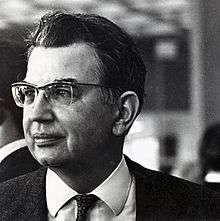
Ronald Coase was one of the world's most influential economists whose work had a profound and lasting impact on public policy and on the study of economics and of law. He served on the faculty and was a founding lecturer from 1932-1934 of the Dundee School of Economics and Commerce, which subsequently became part of the University of Dundee and wrote the manuscript of 'The Nature of the Firm', one of his best-known works, during the years he lectured in Scotland.
Coase received the Alfred Nobel Prize in Economic Sciences in 1991 for his work on the significance of transaction costs and property rights for the institutional structure and functioning of the economy. Seen by many as having laid the intellectual foundations for the rise of broadcasting licence auctions and of carbon trading, Coase continued to publish research almost right up until his death.
He was awarded an honorary degree in 1992, 60 years after he came to Dundee to take up an assistant lectureship. While the Dundee School was initially set up as an independent institution, it marked the beginning of the study of modern economics in Dundee and as such has played a significant role in shaping the development of Economic Studies in the University to the present day.
Student life
Students at Dundee are represented by the University's Students' Representative Council and the Rector in common with other universities in Scotland sharing the ancient organisational structure.
Students' Association
The Dundee University Students' Association (DUSA), unlike many other students' unions in the United Kingdom, is not affiliated to the National Union of Students, mainly due to cost concerns and political objections. It is instead affiliated to the Coalition of Higher Education Students in Scotland (CHESS) and the National Postgraduate Committee. Membership of the Students' Association is automatic for all students of the university, although it is possible under statutes to renounce this membership at any time. The Association, as with its neighbours in the other ancient-organised universities in Scotland, is co-existent with the University's Students' Representative Council.
The DUSA building is located in Airlie Place, in the centre of the University's Main Campus and caters as a private members' club offering bar, nightclub and refectory services for students. DUSA also provides a number of other typical students' union services such as advocacy on behalf of its membership and assistance to individual students. In addition the DUSA facilitates the creation of student societies, as of 2016 there are over 140 student-led societies on campus.
Sports facilities
As of 2016, there are 43 clubs affiliated with the Sports' Union. There is an annual award ceremony for the sports clubs, and a Blues & Colours Ball (see Blue (university sport)) to provide social interaction between the clubs. A popular but informal event is sports clubs joining together on Wednesday night to attend the Students' Union, enabled by the university ending most classes early on a Wednesday afternoon to allow for sports participation - which is particularly appropriate in winter when the sun can set in the mid-afternoon due to Dundee's northerly location.
The Institute of Sport and Exercise, unlike the Sports Union, is directly controlled by the university, but works closely with the students' organisations. Its chief building is located on Old Hawkhill in the main campus, which contains the main indoor sporting facilities and the university's gym.
Following a multimillion-pound refurbishment, the resources and amenities now available at the Institute of Sport & Exercise (ISE) include a 'state-of-the-art' gym with the latest download technology (the first gym in the UK with mp3/mp4 compatible personal viewing screens).
Outdoor facilities are mainly based in the Riverside Sporting Ground, within a reasonable walking distance and bordering the Tay, although there are others - such as tennis courts - spread throughout the main campus. The ISE's 25m swimming pool is located within the Students' Association building on Airlie Place.
The University has been included within the official London 2012 Pre-Games Training Camp Guide, opening up Dundee as a potential training venue for athletes preparing for the Olympics.
Notable sporting achievements of the University include winning the British University Gaelic football Championship in 1994 and being the first team in Scottish rugby history to win the league and SUS Cup double in the 2007/08 season.
Chaplaincy
The University Chaplaincy Centre was constructed in 1974 and extended in 1987 and houses both the University Chapel and a number of other related social facilities. The chapel is often used for concerts.
The university has a full-time chaplain, the Revd Dr Fiona Douglas (since 1997) who is a minister of the Church of Scotland. There are also several part-time associate and honorary chaplains representing other faiths and denominations.
Traditions
Dundee students participate in a number of traditional events during the academic calendar. Towards the start of the year, a standard British Freshers' Week is organised, with a secondary one held when the University reconvenes after the Christmas vacation.
Traditions remaining from Dundee's days as a college of the University of St Andrews include the Gaudie Night (taking its name from the first line of the students' anthem, De Brevitate Vitae) - held early in the first semester and organised both as a Students' Union night and an event organised by the individual schools (for example by the Life Sciences, Medical, Law and Dentistry Societies) where students are assigned academic "parents" from the senior years. Some weeks later, a Raisin (alternatively spelled "Raisen") weekend is held to all new students to repay their academic parents' hospitality. Generally the school society run events are more traditional in nature than the Students' Union event.
Since 2004, the University has organised the Discovery Days series of public lectures hosted by University and visiting academics and persons of note, providing introductions into a number of major fields of work taking place at Dundee.
Student residences
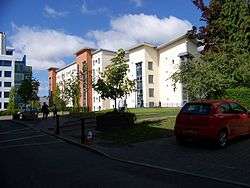
The University has a number of student residences spaced around the city. There is at present an attempt to move some of these halls of residence closer to the main campus. With the closure and re-building of West Park Hall in 2005, all of the halls are now self catered ensuite.
At present, there exist the following university residences:
- Belmont Tower (including Balfour Flats) - Based in the main campus and consisting of two main sections: Belmont Tower, a 1950s construction; the Balfour Flats, a long and low building connected to the tower.
- Belmont Flats - Opened in 2006, these halls are of identical style to those of Heathfield and the new Seabraes halls. It is located on Old Hawkhill, across from the ISE.
- Heathfield - Built at the same time as Belmont Flats. It is located on Old Hawkhill, immediately across from Belmont Tower.
- Seabraes - A number of buildings containing flats, with a new hall identical in style to the new Heathfield and Belmont Halls being built at the foot of the complex. Located near to the south side of the main campus on Roseangle.
- West Park - Located some distance to the west of the main campus, these halls were traditionally popular with medicine students due to their proximity to Ninewells Hospital. Consists of a relatively new complex known as West Park Villas, which are essentially student flats. The old hall (separate from the Villas) was largely torn-down in 2005 (leaving behind only the listed parts of the building) and the new complex (generally known as 'West Park Flats' by the University) will be available from the start of the 2007/08 term.
Some older halls, despite remaining open in the interim until building works were finished, are now out of use - the last students moved out in early 2007. These are:
- Airlie Place & Springfield - A number of flats located in old terrace housing on the main campus, consisting of two streets mainly owned by the University. Both are architecturally noteworthy and have mostly been converted to offices.
- Peterson Hall - An almost brutalist style building to be found further down Roseangle from Seabraes. This hall was traditionally a non-smoking hall of residence, and is now ear-marked for private development.
- Wimberley Houses - The furthest university residences from the main campus, Wimberley - also the closest to Ninewells Hospital in the far west of the city. The residences themselves were a complex of buildings, each comprising a "house" which served as an independent flat for a number of students. They were named for Principal Douglas Wimberley.
Historic collections
Museum Services
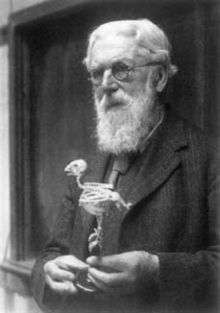
Like many universities, Dundee has significant museum collections acquired over the 125 years of its history. These include fine art, design furniture, textiles, scientific instruments, medical equipment and natural history specimens. Among the highlights are:
- a significant collection of Scottish fine art from the 17th century up to today, displayed throughout the campus as well as in temporary exhibitions in the Tower Foyer and Lamb Galleries
- the D'Arcy Thompson Zoology Museum, featuring specimens, models and other teaching and research aids collected by the author of On Growth & Form while he was Professor of Biology at the University
- the Tayside Medical History Museum, one of the best medical collections in Scotland, based at Ninewells Hospital
- the Duncan of Jordanstone College Collection, featuring works by former students and staff of the art college
The collections are cared for by Museum Services,[73] which are part of the university's Archive, Records Management and Museum Services Department.[74] In 2012 it was announced that Museum Services had been awarded a grant of £100,000 by the Art Fund to develop an art collection inspired by D'Arcy Thompson.[75][76] The current museum curator, Matthew Jarron, is also Convener of the university’s Culture and Arts Forum. This body promotes the various departments of the university involved in cultural activity and runs an annual culture day of short public lectures.[77][78] In January 2014 it was announced that Museum Services had been awarded funding of £32,407 to acquire a new object database to aid the management of its various collections of nearly 30,000 items.[79]
Archive Services
The university's Archive Services[80] maintains the University of Dundee's manuscripts and records collections. The archives hold a wide range of material relating to the University and its predecessor institutions and to individuals associated with the University. Archive Services also holds a number of records relating to individuals, businesses and organizations based in the Tayside area.[81] The records held include a substantial number of business archives relating to the jute and linen industry in Dundee and West Bengal, records of other businesses including the archives of the Alliance Trust and the department store G. L. Wilson, the records of the Brechin Diocese of the Scottish Episcopal Church, the Michael Peto photographic collection and the NHS Tayside Archive.[82][83] Archive Services other collections include the archives of Dundee Repertory Theatre[84] and the papers of the Great War poet Joseph Johnston Lee.[85] In addition to material relating to the local area, the archives have a number of documents relating to other countries, especially India.[86] The Archives also hold the records of the Glasite Church.[87][88][89]
The archives also have book collections including rare books relating to local history.[90] These include the Joan Auld Memorial Collection, an important collection of labour history books donated to the University in 1996 in memory of Joan Auld, the first University archivist, who died in a climbing accident.[91][92]
Notable alumni and staff
This list includes certain persons who are graduates of the University of St Andrews, having studied at the University College or Queen's College in Dundee, as well as graduates of the University of Dundee. This is a result of the incorporation of this institution in the other from 1897 to 1967. It also includes notable former members of staff of these institutions.
Business
- Sir Robert Horton, former Chairman of BP and Railtrack
- Sir George Mathewson, Chairman of the Royal Bank of Scotland Group (2001–2006); Convenor of the Scottish Council of Economic Advisers (2007 -)
Law and Politics
- Professor Zenon Bankowski, Professor Emeritus of Legal Theory at University of Edinburgh
- Malcolm Bruce, former Liberal Democrat Member of Parliament, Rector of the University (1986–89)
- Sir Colin Campbell DL FRSA former Vice-Chancellor of University of Nottingham
- Colin Campbell, Lord Malcolm, Senator of the College of Justice
- Christopher Chope Member of Parliament, former Minister of State and barrister
- Lynda Clark, Baroness Clark of Calton, former Member of Parliament and Advocate General for Scotland, now Senator of the College of Justice
- William Cullen, Baron Cullen of Whitekirk, Advocate, judge, Lord Justice General and Lord President of the Court of Session as well as life peer
- Thomas Dawson, Lord Dawson, former Solicitor General for Scotland and Senator of the College of Justice
- Kurt Deketelaere, Secretary-General of the League of European Research Universities
- William Kirk Dickson, Advocate, librarian and writer, he was Keeper of the Advocates' Library and Librarian of the National Library of Scotland
- Frank Doran, Former Labour Member of Parliament
- Kevin Dunion, Scottish Information Commissioner between 2003 and 2012, as well as former Lord Rector of the University of St Andrews
- Donald Findlay QC, criminal defence advocate
- Maurice Golden, Conservative Member of the Scottish Parliament
- Grant Johnson, former professional footballer and tutor in Private Client Law at the School
- Michael Jones, Lord Jones, Senator of the College of Justice and Honorary President of the School mooting society
- Walter Kamba, Rhodesian lawyer and Chancellor of University of Zimbabwe
- Alhaji Shehu Ladan, Nigerian lawyer
- David Lessels, Senior Lecturer in Law at the University of Aberdeen
- John S. Lowe, visiting professor at University of Dundee and expert in energy law
- Neil MacCormick QC FBA FRSA, professor of jurisprudence at the School and legal philosopher
- Finlay Macdonald, retired minister and Principal Clerk to the General Assembly of the Church of Scotland
- Ronald Mackay, Lord Eassie, Lawyer and judge of the college of justice, sitting in the Inner House of the Court of Session
- Jenny Marra, Member of Scottish Parliament, attended Dundee to read the Diploma in Professional Legal Practice
- Bruce Millan, Labour MP, Secretary of State for Scotland and European Commissioner for Regional Policy
- Lewis Moonie, Baron Moonie - Labour politician, former Minister of State
- Claude Moraes, former Commissioner for Racial Equality, now Member of the European Parliament
- Craig Murray, former British ambassador to Uzbekistan, former President of DUSA, former Rector of the University
- Elijah Ngurare, Namibian politician serving as the secretary general of the SWAPO Party Youth League
- Nhial Deng Nhial, Minister of Foreign Affairs for the Republic of South Sudan
- Kenneth Norrie FRSE, eminent professor of Scots Family Law and Delict Law, head of department at Warwick University and former chair at Kings College London
- Alex Neil, Scottish National Party MSP, Cabinet Secretary for Health and Wellbeing
- George Robertson KT, Baron Robertson of Port Ellen - former Secretary-General of NATO, Labour MP and UK Secretary of State for Defence
- Professor Peter Robson, Professor of Social Welfare Law at the University of Strathclyde
- Thomas Shaw, 1st Baron Craigmyle PC KC LLD, Scottish Liberal politician and judge
- Jim Spence, sports broadcaster
- John Stevenson, Conservative MP and solicitor
- Alan Turnbull, Lord Turnbull, Senator of the College of Justice
- Evadne L. Wade-Garcia, author and Director of the Geology and Petroleum Unit in Belize’s Ministry of Science, Technology and Transportation
- Brian Wilson, former Labour MP and Minister of State
- Boaz Kipchumba Kaino, former MP and Assistant Minister of Lands and Settlement. Republic of Kenya
Media and the Arts
- Johanna Basford, illustrator.[93]
- Naetochukwu Chikwe (Naeto-C), Nigerian musician
- Stefani Dailly, sports journalist, STV News
- David Jackson, musician, best known for his involvement in Van der Graaf Generator
- Alan Johnston, BBC correspondent based in Gaza, famously kidnapped in 2007
- Gary Lightbody, lead singer of Snow Patrol
- Fred McAuley, comedian and former Rector of the University
- James McIntosh, food writer
- Sheelagh McLaren, sports journalist, Radio Clyde and STV News
- Karine Polwart, Scottish folk musician
- Carla Romano, GMTV reporter
- John Suchet, Channel Five news anchor, formerly of ITN
Artists
- Calum Colvin RSA OBE
- Luke Fowler, 2012 Turner Prize Nominee
- David Mach RA, 1988 Turner Prize Nominee
- Lucy McKenzie
- Susan Philipsz OBE, 2010 Turner Prize
- Thomson & Craighead
- Louise Wilson (of Jane and Louise Wilson) 1999 Turner Prize Nominees
Science, Medicine and Engineering
- Dr Azzam Al Dakhil, Minister of Education of Saudi Arabia.
- Sir James W. Black OM FRS FRSE FRCP, notable pharmacologist. Nobel Laureate
- Richard A Collins, scientist and author
- Sir James Alfred Ewing KCB FRS FRSE MInstCE, engineer and physicist
- Margaret Fairlie, Gynaecologist and first female professor in Scotland [17][94]
- Sir Patrick Geddes FRSE, biologist, botanist and urban planning theorist
- Narendra Patel, Baron Patel of Dunkeld KT FMedSci FRSE, notable obstetrician, present Chancellor of the University
- Harold Plenderleith, art conservator and archaeologist.
- Walter Eric Spear FRS FRSE FInstP, notable physicist, pioneered the development of large area electronics and thin film displays
- Sir William Stewart FRS FRSE, Government chief scientific advisor one time professor of Biological Sciences at Dundee
- Sir Robert Alexander Watson-Watt KCB FRS FRAeS, pioneer of Radar
- Dr William Alexander Young, notable doctor, surgeon and epidemiologist who studied and treated many tropical diseases in West Africa, particularly yellow fever
Miscellaneous
- David Shayler, Security Service officer who revealed state secrets to the public, editor of Annasach magazine while at the university
- Bishop Cornelius Sim, Roman Catholic Bishop of the church's Apostolic Vicariate of Brunei Darussalam since the vicariate was established in 1997
See also
- Cyclacel – Spin-off pharmaceutical company from the university
- Dundee Cell Products - Spin-off biotechnology company from the university
- University of Dundee Botanic Garden – University gardens in the West End of the city.
References
- ↑ The motto is taken from the first line of the Magnificat, a prayer offered by Mary, mother of Jesus, the Patron Saint of the City of Dundee.
- 1 2 "Financial Statements for the Year to 31 July 2015" (PDF). University of Dundee. Retrieved 5 May 2016.
- 1 2 "Table 1 - All staff by HE institution, academic employment marker and mode of employment 2014/15". Higher Education Statistics Agency. Retrieved 30 May 2016.
- 1 2 3 "2014/15 Students by HE provider, level, mode and domicile" (XLSX). Higher Education Statistics Agency. Retrieved 19 January 2016.
- ↑ "World University Rankings 2017". Times Higher Education. The Times. 20 September 2016. Retrieved 20 November 2016.
THE World University Rankings
- ↑ http://www.tandfonline.com/doi/full/10.1080/03054985.2015.1082905
- ↑ https://www.timeshighereducation.com/news/most-russell-group-universities-little-better-than-other-pre-92s
- ↑ "Life sciences 2017". Retrieved 20 November 2016.
- ↑ Deed of Endowment
- ↑ "Scotland in the 19th century: Section 5.9: Universities [ebook chapter] / J A Haythornthwaite, 1993". Gdl.cdlr.strath.ac.uk. Retrieved 28 January 2012.
- ↑ "Student lists". Archived from the original on 14 September 2010. Retrieved 4 April 2013.
- ↑ Baxter, Kenneth. "International Women's Day". Archives, Records and Artefacts at the University of Dundee. University of Dundee. Retrieved 25 February 2015.
- ↑ Baxter, Kenneth (2010). ""Matriarchal" or "Patriarchal"? Dundee, Women and Municipal Party Politics in Scotland c.1918-c.1939". International Review of Scottish Studies. 35: 99. Retrieved 28 December 2015.
- ↑ "100 years ago...". Archives, Records and Artefacts at the University of Dundee. Retrieved 31 December 2015.
- 1 2 Baxter, Kenneth, Rolf, Mervyn, and Swinfen, David (2007). A Dundee Celebration. Dundee: University of Dundee. p. 10.
- ↑ "J M Barrie and Rudyard Kipling". Archives, Records and Artefacts at the University of Dundee. University of Dundee. Retrieved 10 May 2016.
- 1 2 "Notable University Figures (3): Professor Margaret Fairlie". Archives, records and Artefacts at the University of Dundee. Retrieved 10 May 2016.
- 1 2 "University of Dundee Charter" (PDF). University of Dundee. Retrieved 29 October 2014.
- ↑ "Centre for Water Law, Policy and Science". University of Dundee. Retrieved 17 October 2016.
- ↑ "From the Chalkface". The Scotsman. 14 February 2007. Retrieved 17 October 2016.
- ↑ "University of Dundee Campus map". University of Dundee. Retrieved 17 October 2016.
- ↑ "Carnelley Building, University of Dundee". Retrieved 30 October 2016.
- ↑ "The Carnegie Building, University of Dundee". Scran. Retrieved 17 October 2016.
- ↑ "Geddes Quadrangle, University of Dundee". Scran. Retrieved 17 October 2016.
- ↑ "Architecture, University of Dundee". Scran. Retrieved 17 October 2016.
- ↑ "Ewing Building, University of Dundee". Scran. Retrieved 17 October 2016.
- ↑ "Notable Figures". University of Dundee Archives. Retrieved 17 October 2016.
- ↑ "Fulton Building, University of Dundee". Scran. Retrieved 17 October 2016.
- ↑ "Tower Building, University of Dundee". Retrieved 30 October 2016.
- ↑ "The Tower Building Outlook City". Retrieved 30 October 2016.
- ↑ "Belmont Halls, University of Dundee". Retrieved 30 October 2016.
- ↑ Royal Charter, s.4.1
- ↑ "University of Dundee announces new Chancellor". University of Dundee, External Relations, Press Office. Retrieved 6 June 2006.
- ↑ Royal Charter s.5
- ↑ http://www.glasgowstudent.net/files/rectorintro.pdf
- ↑ "Baywatch star sinks student hopes". BBC News. 1 February 2001.
- ↑ "Adventurer Mark Beaumont installed as new Dundee University rector". Retrieved 30 October 2016.
- ↑ Baxter, Kenneth; et al. (2007). A Dundee Celebration. Dundee: University of Dundee. p. 61.
- ↑ "Rectorial Elections". Archives, Records and Artefacts at the University of Dundee. Retrieved 27 February 2015.
- ↑ Royal Charter, s.6.1(a)
- ↑ "University of Dundee : External Relations : Press Office". Dundee.ac.uk. 26 March 2009. Retrieved 28 January 2012.
- 1 2 "Professor Pete Downes - Principals Office - The University of Dundee". Dundee.ac.uk. Retrieved 28 January 2012.
- 1 2 3 4 5 Baxter, Kenneth; et al. (2007). A Dundee Celebration. Dundee: University of Dundee. p. 60.
- 1 2 Shafe, Michael (1982). University Education in Dundee: A Pictorial History. Dundee: University of Dundee. p. 201.
- ↑ "New Principal welcomes freshers". Press Release Archive. University of Dundee. 29 September 2000. Retrieved 1 March 2012.
- ↑ "Dundee, University of". The Independent. 23 July 2014. Retrieved 3 October 2016.
- ↑ "Academic Ranking of World Universities 2016 - UK". Shanghai Ranking Consultancy. Retrieved 15 August 2016.
- ↑ "Academic Ranking of World Universities 2016". Shanghai Ranking Consultancy. Retrieved 15 August 2016.
- ↑ "QS World University Rankings 2016/17 - United Kingdom". Quacquarelli Symonds Ltd. Retrieved 7 September 2016.
- ↑ "QS World University Rankings 2016/17". Quacquarelli Symonds Ltd. Retrieved 7 September 2016.
- ↑ "World University Rankings 2016-17 - United Kingdom". Times Higher Education. Retrieved 21 September 2016.
- ↑ "World University Rankings 2016-17". Times Higher Education. Retrieved 21 September 2016.
- ↑ "CWTS Leiden Ranking 2016". CWTS Leiden Ranking 2016. Retrieved 18 July 2016.
- ↑ "University League Table 2017". The Complete University Guide. Retrieved 25 April 2016.
- ↑ "University league tables 2017". The Guardian. 23 May 2013. Retrieved 23 May 2016.
- ↑ "The Times and Sunday Times University Good University Guide 2017". Times Newspapers. Retrieved 23 September 2016.
- ↑ "Facts & Figures". University of Dundee. Retrieved 12 October 2008.
- ↑ "University guide 2015: league table for medicine". Retrieved 3 June 2014.
- ↑ "Search". The Guardian. London. Retrieved 27 May 2010.
- ↑ "Search". The Guardian. London. Retrieved 27 May 2010.
- ↑ Thomson Scientific, 2006
- 1 2 "The University's Reputation - Prospective Students - The University of Dundee". Dundee.ac.uk. Retrieved 28 January 2012.
- ↑ "Top 100 universities for Life Sciences 2016–17". Times Higher Education. Retrieved 29 September 2016.
- ↑ "Top 100 universities for Clinical, Pre-clinical and Health 2015–16". Times Higher Education. Retrieved 1 November 2015.
- ↑ "Duncan of Jordanstone College of Art and Design - Duncan of Jordanstone College of Art and Design - The University of Dundee". Dundee.ac.uk. 20 January 2012. Retrieved 28 January 2012.
- ↑ "The Times - Good University Guide 2013". Retrieved 31 May 2015.
- ↑ "University Guide 2017: League Table for Law". The Guardian. Retrieved 12 July 2016.
- ↑ "NSS Results 2016". Retrieved 30 October 2016.
- ↑ "100 Under 50 Rankings 2015 results". Retrieved 31 May 2015.
- ↑ University of Dundee. "Dundee enters World Top 20 of the under-50s : University News". Retrieved 31 May 2015.
- ↑ "150 Under 50 Rankings 2016 Results". The Independent. Retrieved 12 July 2016.
- ↑ "Dundee is Scottish University of the Year - again!". Retrieved 29 September 2016.
- ↑ Museum Services
- ↑ Archive, Records Management and Museum Services
- ↑ "Museum Services wins £100,000 Art Fund Grant". E-ARMMS Newsletter 11. January 2012. University of Dundee. Retrieved 15 March 2012.
- ↑ "D'Arcy Thompson Zoology Museum RENEW Project". University of Dundee. Retrieved 15 March 2012.
- ↑ "Culture Day is on its way". Archives Records and Artefacts at the University of Dundee. University of Dundee. Retrieved 26 February 2016.
- ↑ "Culture & Arts Forum". Museum Services. University of Dundee. Retrieved 15 October 2012.
- ↑ "News from ARMMS". University of Dundee.
- ↑ Archive Services
- ↑ "University of Dundee Archives Services". University of Dundee. Retrieved 2 June 2011.
- ↑ "University of Dundee Archives Services the Collections". University of Dundee. Archived from the original on 23 October 2013. Retrieved 2 June 2011.
- ↑ "Business Archives". Archives, Records and Artefacts at the University of Dundee. Retrieved 29 February 2016.
- ↑ "MS 316 Dundee Repertory Theatre". Archive Services Online Catalogye. University of Dundee. Retrieved 29 February 2016.
- ↑ "MS 88 Joseph Johnston Lee". Archive Services Online catalogue. University of Dundee. Retrieved 29 February 2016.
- ↑ "International Source List". University of Dundee. Archived from the original on 3 October 2013. Retrieved 10 June 2014.
- ↑ "MS 9 The Glasite Church". Archive Services Online Catalogue. University of Dundee. Retrieved 29 March 2016.
- ↑ "A New Glasite Accession". Archives, Records and Artefacts at the University of Dundee. University of Dundee. Retrieved 29 March 2016.
- ↑ "International Archives Day". Archives, Records and Artefacts at the University of Dundee. University of Dundee. Retrieved 29 March 2016.
- ↑ "Archive Services Online Catalogue". University of Dundee. Retrieved 10 May 2016.
- ↑ "Auld, Joan – Archivist. 1938 - 1995". Dundee Women's Trail. Dundee Women's Trail. Retrieved 10 May 2016.
- ↑ "Special Collections". Archive Services Culture & Information. University of Dundee. Retrieved 10 May 2016.
- ↑ Rosanes, Kerby (8 May 2013). "Featured Artist: The Inky World of Johanna Basford". UCreative.com. UCreative Network. Retrieved 6 November 2014.
- ↑ Baxter, Kenneth (2010). ""Matriarchal" or "Patriarchal"? Dundee, Women and Municipal Party Politics in Scotland c.1918-c.1939". International Review of Scottish Studies. 35: 99.
- Bibliography
- Baxter, K., Rolfe, M. & Swinfen, D. A Dundee Celebration (Dundee, University of Dundee), 2007. The most recent history of the University of Dundee which was produced to mark the fortieth anniversary of the University's founding.
- Shafe, M. University Education in Dundee 1881–1981: A Pictorial History (Dundee: University of Dundee), 1982.
- Southgate, D., University Education in Dundee: A Centenary History (Edinburgh: Edinburgh University Press), 1982.
External links
![]() Media related to University of Dundee at Wikimedia Commons
Media related to University of Dundee at Wikimedia Commons
Coordinates: 56°27′26″N 2°58′49″W / 56.45722°N 2.98028°W

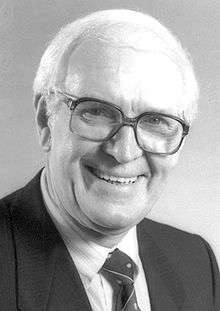
.jpg)

